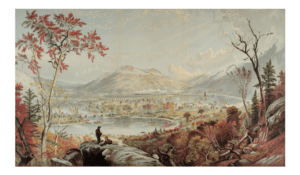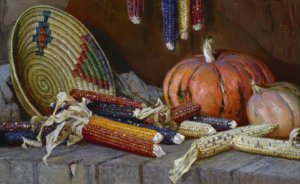Look

Look closely at the picture Husking from 1861. Can you find…
- Two baskets?
- A white shawl?
- Woven corn?
- A bird that is blue?
- Something made of leather?
- An old gun?
- Three black hats?
Discuss

Autumn in New England: Cider Making from 1866 shows how a family is working to make a very popular drink in Colonial America—cider. In this lithograph, a kind of print, we see piles of apples, barrels to hold the cider and the family who is working together to harvest the fruit and make the beverage.
What is your favorite drink in the fall? Share some things that you and your family like to do together in autumn.
Imagine

Imagine that you could walk into the scene in American Autumn… by Jasper Francis Cropsey right now.
What would you smell and hear?
What would you do first?
Would you go fishing?
Would you go speak to the man, boy and the dogs?
What would you say to them?
Create

Check out Harvest Still Life by Oscar Edmund Berninghaus. This painting from 1941 shows ordinary fall objects – ears of corn, a woven basket and pumpkins. Still life paintings show us a new way of looking at ordinary objects. What details, colors and textures does the artist help us notice?
Create your own still life by gathering and combining ordinary, fall-themed objects from around your home and yard. Look for objects of various sizes with different colors, textures, forms and patterns. Try arranging your objects in different ways on a table. Then, capture your favorite arrangement by photographing or drawing your still life.
Otoño actividad de colecciones en línea
Observar

Mire de cerca la imagen Husking (Descascarar) de 1861. ¿Puede encontrar…
-
- ¿Dos cestas?
- ¿Un chal blanco?
- ¿Maíz tejido?
- ¿Un pájaro azul?
- ¿Algo hecho de cuero?
- ¿Una pistola vieja?
- ¿Tres sombreros negros?
Discutir

Autumn in New England: Cider Making (Otoño en Nueva Inglaterra: Elaboración de sidra) desde 1866 muestra cómo una familia está trabajando para hacer una bebida muy popular en la América colonial: la sidra. En esta litografía, una especie de impresion, vemos montones de manzanas, barriles para contener la sidra y la familia que trabaja junta para cosechar la fruta y elaborar la bebida.
¿Cuál es tu bebida favorita en otoño? Comparta algunas cosas que a usted y a su familia les gusta hacer juntos en la remporada del otoño.
Imagina

Imagina que pudieras entrar en escena de American Autumn . . . de Jasper Francis Cropsey ahora mismo.
¿Qué olerías y escucharías?
¿Qué harías primero?
¿Irías a pescar?
¿Irías a hablar con el hombre, o con el chico y los perros?
¿Que les dirías?
Crear

Observa a Harvest Still Life de Oscar Edmund Berninghaus. Esta pintura de 1941 muestra objetos ordinarios de otoño: mazorcas de maíz, una canasta tejida y calabazas. Esta pintura nos muestran una nueva forma de mirar los objetos ordinarios. ¿Qué detalles, colores y texturas nos ayuda a notar el artista?
Cree su propia still life (pintura de naturaleza seca) reuniendo y combinando objetos ordinarios de temática otoñal de su hogar o del patio. Busque objetos de varios tamaños con diferentes colores, texturas, formas y patrones. Intente organizar sus objetos de diferentes maneras en una mesa. Luego, capture su arreglo favorito fotografiando o dibujando su pintura de naturaleza seca.